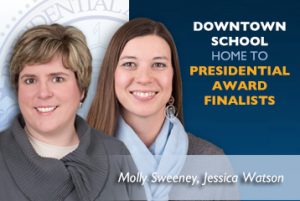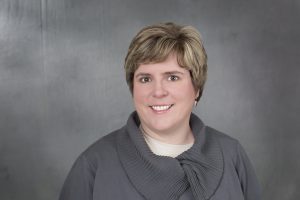Downtown Teachers Are Finalists for PAEMST Award
 For the third year in a row, two of Iowa’s finalists for the Presidential Award for Excellence in Mathematics and Science Teaching are from Des Moines Public Schools.
For the third year in a row, two of Iowa’s finalists for the Presidential Award for Excellence in Mathematics and Science Teaching are from Des Moines Public Schools.
Molly Sweeney and Jessica Watson – both teachers at the Downtown School – are among seven Iowa teachers nominated for the nation’s top science and math educator award. Molly was nominated for math and Jessica for science.
“I am proud that our teachers use research-based instructional strategies,” Downtown School Principal John Johnson said. “They have a keen understanding of how children learn and they have the passion and drive necessary to be outstanding teachers. Molly and Jessica serve as leaders and role models for all teachers and I know they would want to be the first to share this honor with their colleagues.”
The PAEMST is the highest honor a public school math or science teacher can achieve. Nominees from each of the 50 states are eligible for a $10,000 cash prize and a trip to Washington, DC. Established by Congress in 1983, the award program authorizes the bestowal of up to 108 awards each year. Since the PAEMST was created, 10 DMPS teachers have gone on to earn the national honor.
“This is a true honor for the Downtown School and the DMPS,” Johnson said. “Mrs. Sweeney and Mrs. Watson represent the wonderful teaching taking place at the Downtown School and throughout all of the Des Moines Public Schools.”
For more information about the Presidential Award for Excellence in Math & Science Teaching, visit www.paemst.org.
Meet our two PAESMT finalists from DMPS:
MOLLY SWEENEY
After graduating from the University of Northern Iowa, Molly began her teaching career in 1993 at St. Albert’s Catholic School in Council Bluffs, Iowa. Two years later she returned to her home town of Des Moines and began teaching at Windsor Elementary School. Three years later she joined the staff at the Downtown School and began teaching seven and eight year olds. Molly received her Masters of Elementary Education degree from Viterbo University.
She is passionate about teaching students where they are at and using best practices and researched based methods to advance their thinking and understanding. She now teaches nine and ten year old students for half of my day and spends the other half working with students at all age levels with their mathematics development. Molly is also a certified Cognitively Guided Instruction trainer for the state of Iowa, which has allowed her to help teachers throughout Iowa better understand how children think about mathematics and plan for instruction using Common Core problem types and number choices. Molly also collaborated with colleagues to write the book “Transforming the Task with Number Choice K-3”, published by National Council of Teachers of Mathematics.
What is your personal approach to teaching?
When thinking about teaching a group of students, I first begin by looking at each individual child and determining what their level of understanding is on a certain topic. I do this by posing engaging tasks and problems and then I become a careful observer, questioner, and listener. I believe it is vital to have a deep understanding of how the child is thinking about a problem or concept. Then I am able to develop a plan to strengthen and further develop their level of understanding. In my classroom, I allow students to engage, discuss and collaborate with one another. My students become teachers. I encourage and allow my students to teach others whenever possible. It is through teaching that an individual can reach deep understanding.
Historically, many students have been math and/or science averse. How do you counter that in your teaching?
In my classroom, we use and talk about the following motto: “It’s okay to not know, but it is not okay to not try.” I think that motto speaks to how I approach children who are apprehensive towards math and science. All I need is an open and willing mind from a student. Once students allow that to happen, then the world is open to them. Presenting tasks and problems that are real to students and that they see as important in their lives is very motivating. I work to integrate math and science throughout my day, including through the arts. When children engage with math and science concepts in this way, they are less hesitant and they are able to begin to develop their meaning of it on a personal level. It also enables them to recall information because they engage different parts of their bodies.
JESSICA WATSON
 Jessica is originally from Washington, Iowa. She graduated from Simpson College in 2004 with a degree in elementary education and early childhood and in 2007 earned her Master’s Degree in Effective Teaching from Drake University. She has been teaching at the Downtown School since 2004.
Jessica is originally from Washington, Iowa. She graduated from Simpson College in 2004 with a degree in elementary education and early childhood and in 2007 earned her Master’s Degree in Effective Teaching from Drake University. She has been teaching at the Downtown School since 2004.
Some of the leadership roles Jessica has held include Project Based Learning professional development instructor, the school’s Science Leader, and most recently as the school’s Teaching Garden Coordinator. She has taught courses through Heartland AEA and the Business Education Alliance.
What is your personal approach to teaching?
My personal approach to teaching is based on the idea that if the instruction is engaging and purposeful, the students will find learning meaningful. I’ve had some fantastic mentors and teammates that have impressed on me the importance of using researched-based quality resources, taking advantage of community events and experts, and using real-world experiences to involve students in the learning process. Additionally, I believe in creating an atmosphere of community learning and inquiry. When students are encouraged to see themselves as an integral part of a larger learning group, they are more willing to take risks, give and receive feedback and be active in the learning process. My goal is to encourage them to wonder about the world around them, make conjectures about ideas we’ve investigated or apply learning to new situations.
Historically, many students have been math and/or science averse. How do you counter that in your teaching?
It’s unfortunate that students in the elementary grades begin to have a negative attitude about math or science. Although this has many causes, I believe that some science, social studies, and math teachers try to use one-size-fits-all materials and scripted units. Teachers need to put forth effort to differentiate instruction and meet students’ needs. Math instruction needs to build on prior knowledge so students can make connections and extend their learning. Science and social studies instruction should allow for student choice, so children feel a vested interest in the information they are learning. I believe in using real-life experiences in both science and math. When students are faced with real problems that need solutions, they are much more motivated to ask questions, research to find answers and make conclusions about their results. It’s so rewarding to see all students participating in problem-based tasks, even those with adverse feelings toward science and math.





